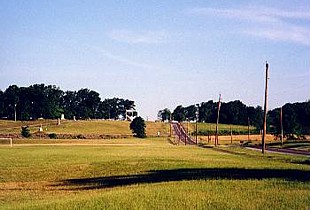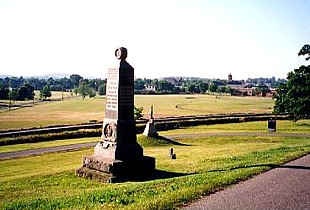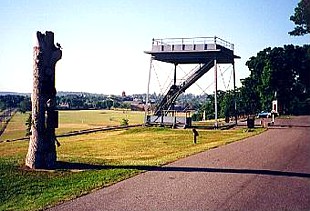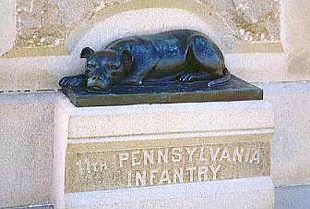|
Battle of Oak Ridge
Battle of Gettysburg
Battle of Gettysburg Oak Ridge Map McPherson Farm McPherson’s Ridge Battlefield Map Cemetery
Hill Location Gettysburg Orders of Battle Union Confederate Order of Battle Maps Army Locations of Armies
Oak Ridge and Battle of Gettysburg
| The eastern side of Oak Ridge |

|
| Oak Ridge, Battle of Gettysburg |
Union troops from General John C. Robinson's Division of the First Corps
were aligned on this ridge during the afternoon of July 1, 1863, and stubbornly held this position against repeated attacks
by General Robert Rodes' Division. Brig. General Henry Baxter's Brigade, composed of Massachusetts, New York, and Pennsylvania
regiments, was posted at the apex of the ridge where the Mummasburg Road intersects the summit, with a portion of the command
in line southward toward the Lutheran Seminary. In the opening phases of the afternoon battle, Baxter's soldiers threw back
one determined southern assault and then destroyed General Alfred Iverson's North Carolina Brigade in the field west of this
ridge. By 2 o'clock they were running low on ammunition and energy, and General Robinson replaced them with Brig. General
Gabriel Paul's Brigade. Within minutes the Confederates reappeared in the Union front, sweeping around the Union position
in a more coordinated attack. The pressure grew on Paul's men as the afternoon wore on and General Paul was severely wounded
by a musket ball that passed through both eyes. (Remarkably, he survived this debilitating wound.)
| A modern day view of Gettysburg from Oak Ridge |

|
| Present-day view of Gettysburg from Oak Ridge |
By 3:30 P.M., however, the entire Federal line from here to McPherson's Ridge had begun to crumble and Paul's regiments were ordered to retreat to the Seminary where other troops of the 1st Corps were
making a final stand. To give the brigade time to get away, the 16th Maine Infantry remained on Oak Ridge, holding off the
Confederates until they were trapped and forced to surrender. The men gave up their weapons only after they had taken down
and destroyed the regimental flag so that it would not be captured. To prevent the humiliation of surrendering his sword to
the Confederates, Colonel Charles W. Tilden, the 16th's defiant commander, drove his sword into the earth and snapped it in
two, leaving only the guard and grip for a southern trophy. The sacrifice of the 16th Maine gave the rest of the brigade valuable
minutes to make their way down Oak Ridge to a point where the railroad bed cut through the ridge. The men followed the embankment
toward Gettysburg with other troops and ran a gauntlet of Confederate fire before dashing into the borough streets.
Placed in the fields east of Oak Ridge were two under strength divisions of the Eleventh Corps. General Carl
Schurz, placed in temporary command of the corps, deployed his regiments in the fields around the "Alms House", which was
the county home for the poor. Fighting began when Georgians of General George Doles' Brigade moved down the Carlisle Road
and engaged the Union troops on the county farmland while southern batteries sent shells into the Union positions. Union artillery
replied and drove some of the Confederate batteries to cover. The front appeared to be stable when suddenly, Confederate artillery
boomed from the east and shells whirred into the exposed Union right flank. General Jubal Early's Division had arrived from
the direction of York and immediately attacked the open Union flank anchored on a small hill, today called "Barlow's Knoll".
Schurz's corps collapsed and the town was soon full of retreating Union troops, pursued by victorious Confederates.
| Summit of Oak Ridge and the 1895 observation tower |

|
| Summit of Oak Ridge and the 1895 observation tower |
From the Oak Ridge observation tower, visitors can get a great view of the
entire first day's battlefield, Gettysburg College and the town. The tower is located near the point where the two Union corps
(the First and Eleventh) connected. This is one of three surviving War Department-era towers, constructed at the turn of the
century. This particular tower was modified in the 1960's due to a structural failure in the upper section.
There are also some interesting and unique monuments placed here by veterans
of the battle that help tell the story of the action here on that warm July 1st. One in particular is that which commemorates
the services of the 90th Pennsylvania Infantry, sculpted in the shape of a large oak tree. Veterans of the 90th recalled the
large stump of the tree that stood near this spot during the battle, and voted to place its likeness in granite, adorned with
the bronze accoutrements of war, to mark the site where the regiment fought that day.
One of the most symbolic monuments on Oak Ridge is that to the 11th Pennsylvania Infantry, upon which stands
the full-size bronze likeness of a Union soldier overlooking the fields where Iverson's North Carolinians made their fateful
charge. This monument has a unique addition at its base; a bronze statuette of a small, mixed breed dog named "Sallie", a
stray that one day wandered into the camp of the 11th Pennsylvania and became attached to one of the regiment's soldiers.
Her appearance in the ranks while on dress parade or during the march was a curious site to many, though it was not uncommon
for soldiers to informally "adopt" a pet of some sort, and the men in the rank and file evidently enjoyed Sallie's companionship.

| Pennsylvania Infantry's loyal mascot |

|
| The 11th Pennsylvania Infantry's loyal mascot |
Sallie made the long trek from Virginia to Pennsylvania in the summer of
1863 and went into the fighting on July 1st alongside her human comrade. When the Union line collapsed that afternoon, survivors
of the 11th Pennsylvania staggered through Gettysburg to Cemetery Hill, where they reformed and counted their losses. Among the missing was the small dog, lost in the confusion of battle or during
the retreat. Late on July 5th, a burial detail from the regiment made their way back to the scene where the regiment fought
on Oak Ridge. Here they discovered Sallie lying among the corpses of the regiment which had adopted her. Very much alive and
loyal to a fault, she had remained with her fallen master. Sallie was taken by the detail back to the regiment and informally
adopted by the men as the regiment's mascot. Sallie remained with her regiment, sharing in the dangers and duties that her
masters faced until she was killed at the Battle of Hatcher's Run, Virginia, in 1864.
When the veterans of the 11th Pennsylvania Infantry erected their monument
at Gettysburg in 1890, they chose to add the likeness of the homely little dog that brought happiness to their lives as soldiers,
for she was the most humble symbol of loyalty they had experienced during the war.
Source: National Park Service; Gettysburg National Military Park
Recommended Reading: Gettysburg--The First Day,
by Harry W. Pfanz (Civil War America)
(Hardcover). Description: Though a great deal has been
written about the battle of Gettysburg, much of it has focused
on the events of the second and third days. With this book, the first day's fighting finally receives its due. Harry Pfanz,
a former historian at Gettysburg National
Military Park and author of
two previous books on the battle, presents a deeply researched, definitive account of the events of July 1, 1863. Continued below…
After sketching the background
of the Gettysburg
campaign and recounting the events immediately preceding the battle, Pfanz offers a detailed tactical description of the first
day's fighting. He describes the engagements in McPherson Woods, at the Railroad Cuts, on Oak
Ridge, on Seminary Ridge, and at Blocher's Knoll, as well as the retreat of Union forces through Gettysburg and the Federal rally on Cemetery Hill. Throughout, he draws on
deep research in published and archival sources to challenge some of the common assumptions about the battle--for example,
that Richard Ewell's failure to press an attack against Union troops at Cemetery Hill late on the first day ultimately cost
the Confederacy the battle.
Recommended Reading:
Damn Dutch: Pennsylvania Germans
at Gettysburg, by David L. Valuska (Author), Christian
B. Keller (Author), Don Yoder (Foreword), Scott Hartwig (Contributor), Martin Oefele (Contributor) (Hardcover). Review: This is the first work to highlight the contributions of regiments of the Pennsylvania Dutch and the
post 1820 immigrant Germans at the Battle of Gettysburg. On the first day, the 1st Corps, in which many of the Pennsylvania
Dutch regiments served, and the half-German 11th Corps, which was composed of five regiments of either variety, bought, with
their blood, enough time for the federals to adequately prepare the high ground, which proved critical in the end for the
Union victory. On the second day, they participated in beating back Confederate attacks that threatened to crack the Union
defenses on Cemetery Hill and in other strategic locations.
About
the Authors: David L. Valuska is Freyberger
professor of Pennsylvania German studies at Kutztown University
and executive director of the Pennsylvania German Cultural Heritage Center. Christian B. Keller is assistant professor of
American history at Dickinson College.
Scott Hartwig has been an interpretive park ranger at Gettysburg
National Military Park
since 1980. Martin Oefele is a former professor of American history at the University
of Munich.
Recommended
Reading:
The Artillery of Gettysburg (Hardcover). Description:
The battle of Gettysburg in July 1863, the apex of the Confederacy's
final major invasion of the North, was a devastating defeat that also marked the end of the South's offensive strategy against
the North. From this battle until the end of the war, the Confederate armies largely remained defensive. The Artillery of
Gettysburg is a thought-provoking look at the role of the artillery during the July 1-3, 1863 conflict. Continued below...
During the
Gettysburg
campaign, artillery had already gained the respect in both armies. Used defensively, it could break up attacking formations
and change the outcomes of battle. On the offense, it could soften up enemy positions prior to attack. And even if the results
were not immediately obvious, the psychological effects to strong artillery support could bolster the infantry and discourage
the enemy. Ultimately, infantry and artillery branches became codependent, for the artillery needed infantry support lest
it be decimated by enemy infantry or captured. The Confederate Army of Northern Virginia had modified its codependent command
system in February 1863. Prior to that, batteries were allocated to brigades, but now they were assigned to each infantry
division, thus decentralizing its command structure and making it more difficult for Gen. Robert E. Lee and his artillery
chief, Brig. Gen. William Pendleton, to control their deployment on the battlefield. The Union Army of the Potomac
had superior artillery capabilities in numerous ways. At Gettysburg,
the Federal artillery had 372 cannons and the Confederates 283. To make matters worse, the Confederate artillery frequently
was hindered by the quality of the fuses, which caused the shells to explode too early, too late, or not at all. When combined
with a command structure that gave Union Brig. Gen. Henry Hunt more direct control--than his Southern counterpart had over
his forces--the Federal army enjoyed a decided advantage in the countryside around Gettysburg. Bradley
M. Gottfried provides insight into how the two armies employed their artillery, how the different kinds of weapons functioned
in battle, and the strategies for using each of them. He shows how artillery affected the “ebb and flow” of battle
for both armies and thus provides a unique way of understanding the strategies of the Federal and Union
commanders.
Recommended Reading: Gettysburg: A Testing of Courage. Description: America's Civil War raged for more than four years, but it is the three days of fighting in the Pennsylvania countryside in July 1863 that continues to fascinate, appall, and inspire new
generations with its unparalleled saga of sacrifice and courage. From Chancellorsville, where General Robert E. Lee launched
his high-risk campaign into the North, to the Confederates' last daring and ultimately-doomed act, forever known as Pickett's
Charge, the battle of Gettysburg gave the Union army a victory that turned back the boldest and perhaps greatest chance for
a Southern nation. Continued below...
Now, acclaimed
historian Noah Andre Trudeau brings the most up-to-date research available to a brilliant, sweeping, and comprehensive history
of the battle of Gettysburg that sheds fresh light on virtually every aspect of it. Deftly balancing his own
narrative style with revealing firsthand accounts, Trudeau brings this engrossing human tale to life as never before.
Recommended
Reading: The Maps of Gettysburg: The Gettysburg
Campaign, June 3 - July 13, 1863 (Hardcover). Description: More academic and photographic
accounts on the battle of Gettysburg exist than for all other
battles of the Civil War combined-and for good reason. The three-days of maneuver, attack, and counterattack consisted of
literally scores of encounters, from corps-size actions to small unit engagements. Despite all its coverage, Gettysburg remains one of the most complex and difficult to understand battles of the war.
Author Bradley Gottfried offers a unique approach to the study of this multifaceted engagement. The Maps of Gettysburg plows
new ground in the study of the campaign by breaking down the entire campaign in 140 detailed original maps. These cartographic
originals bore down to the regimental level, and offer Civil Warriors a unique and fascinating approach to studying the always
climactic battle of the war. Continued
below...
The Maps of
Gettysburg offers thirty "action-sections" comprising the entire campaign. These include the march to and from the battlefield,
and virtually every significant event in between. Gottfried's original maps further enrich each "action-section." Keyed to
each piece of cartography is detailed text that includes hundreds of soldiers' quotes that make the Gettysburg
story come alive. This presentation allows readers to easily and quickly find a map and text on virtually any portion of the
campaign, from the great cavalry clash at Brandy Station on June 9, to the last Confederate withdrawal of troops across the
Potomac River on July 15, 1863. Serious students of the battle will appreciate the extensive
and authoritative endnotes. They will also want to bring the book along on their trips to the battlefield… Perfect for
the easy chair or for stomping the hallowed ground of Gettysburg,
The Maps of Gettysburg promises to be a seminal work that belongs on the bookshelf of every serious and casual student of
the battle.
Recommended
Reading:
ONE CONTINUOUS FIGHT: The Retreat from Gettysburg and
the Pursuit of Lee's Army of Northern Virginia, July 4-14, 1863 (Hardcover) (June
2008). Description: The titanic three-day
battle of Gettysburg left 50,000 casualties in its wake, a
battered Southern army far from its base of supplies, and a rich historiographic legacy. Thousands of books and articles cover
nearly every aspect of the battle, but not a single volume focuses on the military aspects of the monumentally important movements
of the armies to and across the Potomac River. One Continuous Fight: The Retreat from Gettysburg and the Pursuit of Lee's Army of Northern Virginia, July
4-14, 1863 is the first detailed military history of Lee's retreat and the Union effort to catch and destroy the wounded Army
of Northern Virginia. Against steep odds and encumbered with thousands of casualties, Confederate commander Robert E. Lee's
post-battle task was to successfully withdraw his army across the Potomac River. Union commander George G. Meade's equally
difficult assignment was to intercept the effort and destroy his enemy. The responsibility for defending the exposed Southern
columns belonged to cavalry chieftain James Ewell Brown (JEB) Stuart. If Stuart fumbled his famous ride north to Gettysburg, his generalship during the retreat more than redeemed his
flagging reputation. The ten days of retreat triggered nearly two dozen skirmishes and major engagements, including fighting
at Granite Hill, Monterey Pass, Hagerstown, Williamsport, Funkstown,
Boonsboro, and Falling Waters. Continued
below...
President Abraham
Lincoln was thankful for the early July battlefield victory, but disappointed that General Meade was unable to surround and
crush the Confederates before they found safety on the far side of the Potomac. Exactly what Meade did to try to intercept the fleeing Confederates, and how the
Southerners managed to defend their army and ponderous 17-mile long wagon train of wounded until crossing into western Virginia on the early morning of July 14, is the subject of this study.
One Continuous Fight draws upon a massive array of documents, letters, diaries, newspaper accounts, and published primary
and secondary sources. These long-ignored foundational sources allow the authors, each widely known for their expertise in
Civil War cavalry operations, to describe carefully each engagement. The result is a rich and comprehensive study loaded with
incisive tactical commentary, new perspectives on the strategic role of the Southern and Northern cavalry, and fresh insights
on every engagement, large and small, fought during the retreat. The retreat from Gettysburg
was so punctuated with fighting that a soldier felt compelled to describe it as "One Continuous Fight." Until now, few students
fully realized the accuracy of that description. Complimented with 18 original maps, dozens of photos, and a complete driving
tour with GPS coordinates of the entire retreat, One Continuous Fight is an essential book for every student of the American
Civil War in general, and for the student of Gettysburg in
particular. About the Authors: Eric J. Wittenberg has written widely on Civil War cavalry operations. His books include Glory
Enough for All (2002), The Union Cavalry Comes of Age (2003), and The Battle of Monroe's Crossroads and the Civil War's Final
Campaign (2005). He lives in Columbus, Ohio.
J. David Petruzzi is the author of several magazine articles on Eastern Theater cavalry operations, conducts tours of cavalry
sites of the Gettysburg Campaign, and is the author of the popular "Buford's Boys." A long time student of the Gettysburg
Campaign, Michael Nugent is a retired US Army Armored Cavalry Officer and the descendant of a Civil War Cavalry soldier. He
has previously written for several military publications. Nugent lives in Wells, Maine.
Recommended Reading: The History Buff's Guide to Gettysburg
(Key People, Places, and Events) (Key People, Places, and Events). Description: While most history books are dry monologues of people, places, events and dates,
The History Buff's Guide is ingeniously written and full of not only first-person accounts but crafty prose. For example,
in introducing the major commanders, the authors basically call Confederate Lt. Gen. Richard S. Ewell a chicken literally.
Continued below...
'Bald, bug-eyed,
beak-nosed Dick Stoddard Ewell had all the aesthetic charm of a flightless foul.' To balance things back out a few pages later,
they say federal Maj. Gen. George Gordon Meade looked like a 'brooding gargoyle with an intense cold stare, an image in perfect
step with his nature.' Although it's called a guide
to Gettysburg,
in my opinion, it's an authoritative guide to the Civil War. Any history buff or Civil War enthusiast or even that casual
reader should pick it up.

|

